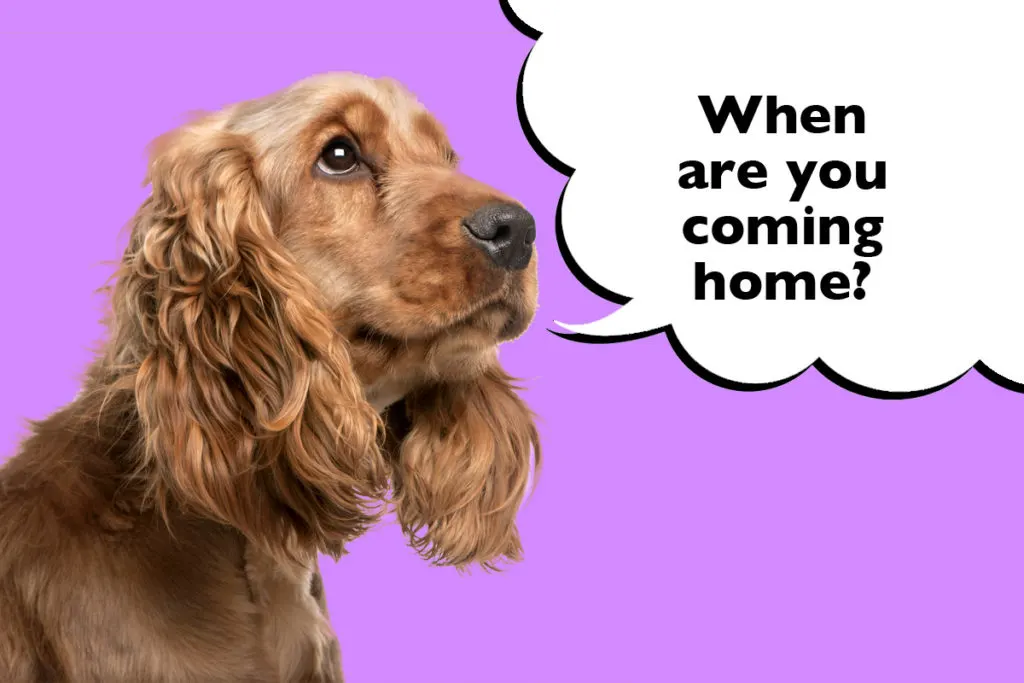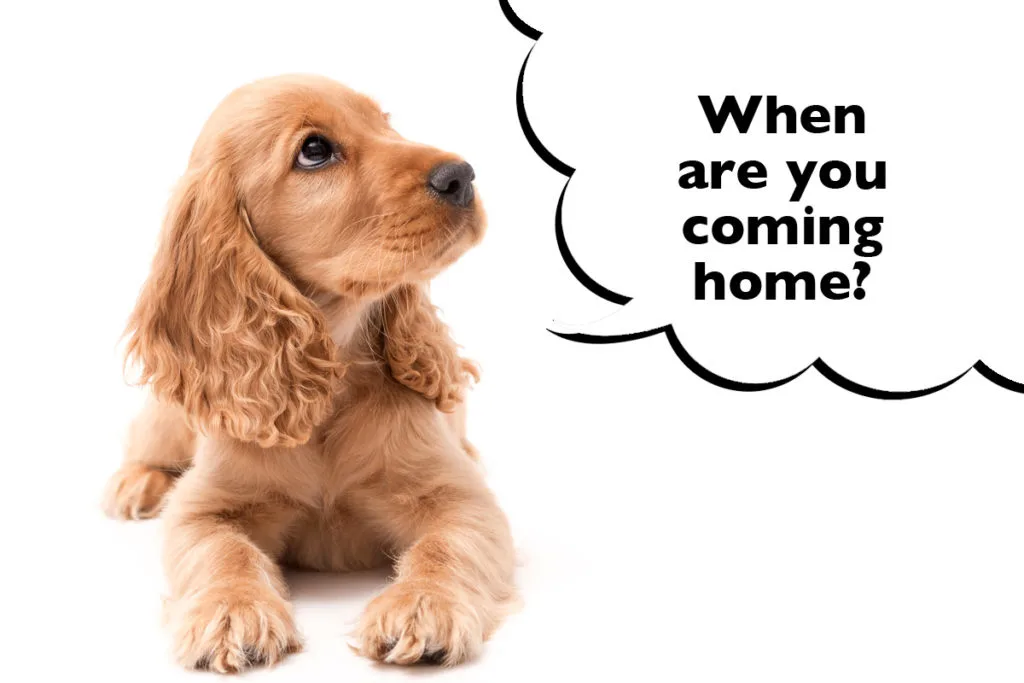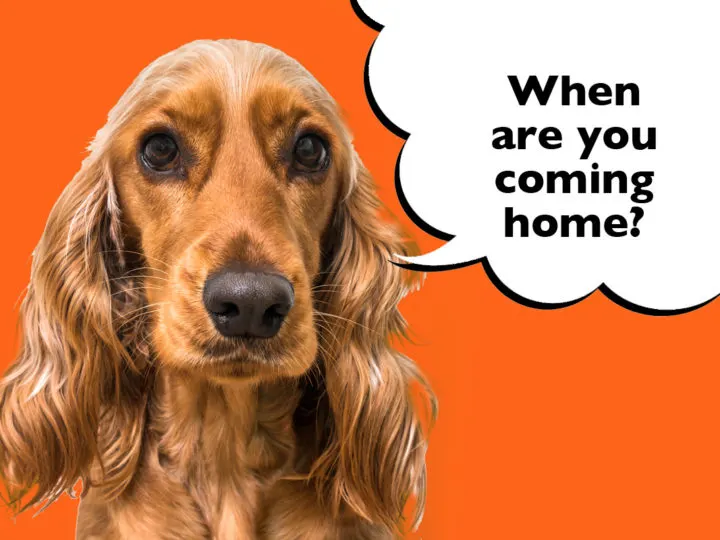Do Cocker Spaniels Get Separation Anxiety?
Do you have a Cocker Spaniel? Are they getting stressed or anxious when you’re not around? Maybe they don’t even like it when you leave the room? Here’s everything you need to know about whether Cocker Spaniels get separation anxiety.
Do Cocker Spaniels Get Separation Anxiety? Yes, Cocker Spaniels are prone to developing separation anxiety. Bred as gundogs since the late 1800s, their primary role is to work closely alongside their handlers to retrieve game. The strong bond they have with their owners can lead to them becoming overly attached.
Read on to find out what the behavioural signs of separation anxiety in Cocker Spaniels are, and what dog training tips you can use right now to help desensitise them to you leaving the house.
Never use the advice in this article as a substitute for professional veterinary advice or treatment. I am NOT a Vet, qualified dog trainer or dog behaviourist. This article is based on research, personal opinion and experience of owning dogs over the last 12+ years.
What Is Separation Anxiety In Cocker Spaniels?
Separation anxiety is a behavioual condition that some Cocker Spaniels suffer from. They’re a very loving and affection dog breed that want to spend every minute with their owners.
Because they form such strong attachments with their owners, it can make it difficult for them to cope on their own.
This means they may feel anxious, distressed, overwhelmed and upset when you leave the room or house, or go out to work.
However, not all Cocker Spaniels will get separation anxiety and some cases will be more severe than others. It depends on the individual dog and their situation.
Does My Cocker Spaniel Have Separation Anxiety?
If your Cocker Spaniel shows any of the following signs when they’re left alone then they could have separation anxiety:
- Barking, howling or crying excessively
- Trying to escape, scratching walls and doors
- Extreme over-excitement when you get home
- Destroying your possessions, shoes, clothes, etc
- Chewing furniture and accessories like cushions, remote controls etc
- Raiding the bins and shredding up the rubbish
- Weeing or pooing in the house
- Coprophagia (eating their own poop)
- Pacing round the room, unable to settle
- Lying down looking despondent, but not sleeping
- Ripping up their bed or toys
- Refusing water or treats left out for them
All of these symptoms can be distressing and upsetting to see, so you need to work on training to help your Cocker Spaniel overcome the condition and feel calmer when alone.
How Can I Help My Cocker Spaniel With Their Separation Anxiety?
If you think your Cocker Spaniel has got separation anxiety, then there are some things that may help them:
Get A Camera To Watch Your Cocker Spaniel
A camera allows you to see exactly how your Cocker Spaniel is feeling and behaving when you’re not there.
Most cameras notify you of any noise or movement. Some, even let you speak to your Cocker Spaniel to try and comfort them.
Some, that are specially designed for pets, will dispense treats as well, which can be useful for rewarding calm behaviour.

Do Desensitisation Training With Your Cocker Spaniel
We tend to do the same routine right before we leave the house. Shoes on, coat on, pick up keys etc.
Your Cocker Spaniel will have noticed this too, which can get their anxiety going even before you’ve left the house!
To overcome this, you need to work on desensitivity training. This is basically where you regularly get ready to go out without actually going anywhere.
Just sit there with your coat and shoes on and have a coffee, read a book or scroll Instagram.
Doing this a couple of times a day will eventually stop triggering your Cocker Spaniel to you leaving.
The next step is to get ready to go out but simply walk into the next room, returning in a minute or two. Slowly building the time up over the next few days.
Over time, you’ll get to a point when you can go outside for 5 minutes before returning. Then 10 minutes, then 20 minutes – and so on. Again, you need to do this slowly and build up the time.
Always reward your Cocker Spaniel for calm behaviour. They’ll soon realise that just because you’ve picked up your keys, doesn’t automatically mean you’re about to leave them.
Create Background Noise For Your Cocker Spaniel
Leaving the TV or radio on for your Cocker Spaniel makes some background noise. This can help them feel less lonely than if the house is silent.
It also lessens any noises that come from outside, which can disturb them too.
There are playlists available to download for free, designed especially for dogs! You can even find things like this for free on YouTube if you have a quick search.
Never Punish Your Cocker Spaniel
Separation anxiety can make your Cocker Spaniel behave out of character.
It’s understandably frustrating to come home and find they’ve had an accident in the house, or they’ve damaged your furniture or new blanket.
But, never punish or shout at your Cocker Spaniel for this behaviour. They’re not doing it to upset you, they’re just having a hard time coping on their own!
Don’t Make A Big Deal About Leaving Your Cocker Spaniel
The bigger fuss you make of your Cocker Spaniel before you leave them, the worse their anxiety is likely to be.
If you act like it’s nothing important, it can make their lives a little easier.
So keep calm and don’t give them too much attention when you leave or get home. This is probably harder for you than it is for them!
Give Your Cocker Spaniel A Food Toy To Keep Them Busy
Cocker Spaniels love their food, so use this to your advantage!
Give them a Kong stuffed with cream cheese or dog-safe peanut butter (xylitol free) when you’re going out.
Not only will this distract them for a few minutes while they eat it, but it’ll also create a positive association. You leaving means they get a tasty treat, which can help them feel more at ease.
Make Sure Your Cocker Spaniel Is Comfortable
Cocker Spaniels love to snuggle in a comfortable bed, so make sure they’ve got access to one.
Some will prefer the comfort of a crate, covered in a blanket, especially if they’re already crate trained.
Others will be happy in a quiet space in the house. Whatever suits your Cocker Spaniel best.
Just be sure not to lock your Cocker Spaniel in a crate of you’re going out for hours at a time. This isn’t fair and could even make their anxiety worse.
Gradually Increase The Time Your Cocker Spaniel Is Left Alone
Start by only leaving your Cocker Spaniel for a few minutes at a time. You can even start this within your home, without leaving the house at first.
Leave them in a separate room while making a coffee for example. Build up slowly from here to 10 minutes, 15 minutes and so on.
This is a better alternative to leaving them alone for several hours right at the start.

Do Independence Training With Your Cocker Spaniel
Cocker Spaniels can be quite clingy, they want to be with you all the time! So, it’s a good idea to teach them how to be more independent.
Scatter some treats into a snufflemat or food toy and let them sniff them out independently.
This’ll help build their confidence when they realise it’s okay or fun to do things on their own sometimes!
Make Sure Your Cocker Spaniel Is Exercised
Adult Cocker Spaniels need at least an hour of daily exercise. Without this, they’ll quickly get bored and frustrated, which can make their separation anxiety even worse.
So go for a steady walk with lots of chances for them to sniff before you leave. This helps keep them calm and relaxed before they’re left alone.
Be Patient With Your Cocker Spaniel
Overcoming separation anxiety tends to take a while. Especially if your Cocker Spaniel’s been feeling this way for a long time.
So, it’s crucial you remain patient with them and not try to rush the process. If at any point, they seem stressed, then don’t try to push them further.
Leave Your Cocker Spaniel At The Same Time Each Day
Leaving and returning at the same time every day can help your Cocker Spaniel know what to expect.
That way, they won’t be left wondering if you’re ever coming home, because they’ll learn you always will.
Keeping to a similar routine can be really beneficial for behavioural issues.
Remove Anything Your Cocker Spaniel Could Damage
Make sure to move anything you don’t want to get damaged.
Shoes, clothes, towels, remote controls, cushions etc. can all be chewed and potentially harm your Cocker Spaniel if they swallow them.
Try not to leave anything within reach that could potentially cause them any harm.
Use Pheromone Plug-Ins With Your Cocker Spaniel
Pheromone plug-ins and sprays can help your Cocker Spaniel feel more secure. They send calming messages to your Cocker Spaniel which can be comforting for them.
You could spray them onto a blanket and let them choose if they want to go and lie on it or not.
Leave Some Toys Out For Your Cocker Spaniel
If you feel it’s safe to do so, leaving out some robust toys for your Cocker Spaniel to play with can be helpful.
If boredom is aggravating their separation anxiety, then giving them something new can help alleviate that.
It also means that if they’re going to shred or chew on something, at least it’s their toys – and not your belongings!
So, there you have it! Some Cocker Spaniels are prone to developing separation anxiety. They’re an extremely loving and affectionate breed who want to spend every waking minute with their owners. Unfortunately, they can get overly attached which can sadly lead to behavioural problems when they’re left alone. However, with patience and time, you can desensitise your Cocker to you leaving the house and teach them to feel calmer when you’re not there!
What do I do next?
Thank you for reading all the way to the end of this article, your support for my blog means everything to me! If you found this article helpful, please kindly share below. Thank you!

